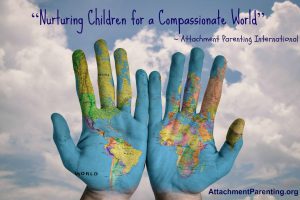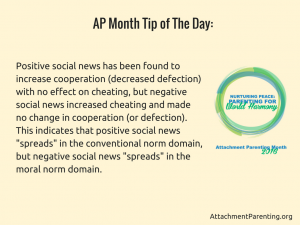Category: AP Month
Raising compassionate kids in a violent world
Editor’s Note: This post was originally published on 6/24/2016. Through this year’s AP Month theme, “Nurturing Peace: Parenting for World Harmony,” we have been focusing on promoting peace and harmony in the home as well as around the world. This article is a great reminder that despite the many challenges violence can pose, we can still cultivate compassion and peace in our children.
API promotes parenting practices that create strong, healthy emotional bonds between children and their parents. For life.
So they can take those bonds with them into their adult lives and share them with their children. And their children can do the same.
A life cycle of compassion and connection.
Today, we are featuring resources from the National Association of School Psychologists that offer guidelines for dealing with the difficult subject of children and violence — in particular, war and terrorism.
In recent years, increasingly, there have been numerous heartbreaking mass shootings and terror activities in the United States and around the globe.
In the aftermath of such distressing incidents, many parents are wondering how to react: How much information? What and how should we communicate to our kids? And as we reflect on such painful incidents and move towards healing, another imperative question we need to ask ourselves is, What role do we play, as parents to children who will become the adults of tomorrow?
With ongoing wars, mass shootings and terrorist threats, it can be challenging to escape the display of violence from the extensive media and internet coverage — it’s a heavy dose for children to bear. While we should do our best to limit our kids’ exposure to violence, we should also acknowledge that this is the reality of the world we live in, and we need to navigate around helping children find comfort and provide them with the support they need. It is our responsibility as parents and caregivers to address our children’s emotional needs — to that end, they need us to help them understand and cope with the phenomenon of violence.
 It’s unrealistic to think that we can completely shield our kids from being exposed to incidents, such as the recent one in Orlando. Albeit, as parents, we can foster a secure environment in our homes for our children to be resilient in the face of tragedies. API promotes a secure emotional bond in the parent-child relationship — cultivating trust, a sense of security, social competence, confidence, and empathetic qualities in a child…all of which are beneficial when experiencing adversities.
It’s unrealistic to think that we can completely shield our kids from being exposed to incidents, such as the recent one in Orlando. Albeit, as parents, we can foster a secure environment in our homes for our children to be resilient in the face of tragedies. API promotes a secure emotional bond in the parent-child relationship — cultivating trust, a sense of security, social competence, confidence, and empathetic qualities in a child…all of which are beneficial when experiencing adversities.
Open communication, honesty, and trust between a parent and a child are essential ingredients for developing a strong relationship — one that is valuable when dealing with sensitive, emotional-trigger situations. This guide explores tips for parents and educators to help children cope with terrorism.
Naturally, children may feel angry and frightened in their reaction to acts of violence. To help them work through emotionally charged issues in a positive way, is it helpful to teach them compassion, empathy, and kindness in our homes and our schools.
The following are some helpful tips to consider in promoting compassion and acceptance in crisis:
- Model compassion and acceptance of differences — Children take their emotional cues from the significant adults in their lives.
- Provide useful information — Accurate information about people, events, reactions, and feelings is empowering. Use language that is developmentally appropriate for children.
- Stop any type of harassment or bullying immediately — Make it clear that such behavior, in any form (in person, online, social media) is unacceptable. Talk to the children involved about the reasons for their behavior.
- Explore children’s fears — Even children who can describe what happened may not be able to express fears, questions, or describe assumptions or conclusions they may have made. Use activities, role-playing, and discussions to explore their fears about the events and their feelings about various groups from diverse cultures or lifestyles.
- Identify “heroes” of varying backgrounds involved in response to traumatic events — These include firefighters, police officers, rescue workers, military personnel, public officials, medical workers, teachers, faith leaders, public figures, and regular citizens who work to help keep students, families, schools, and communities safe.
- Read books with your children or students that address prejudice and hate — There are many, many stories appropriate for varying age groups that can help children think about and define their feelings regarding these issues.
Parents are their children’s first and most empowering role models. Meeting our children’s needs by nurturing them with sensitivity, kindness, and compassion serves as a model for children to observe and learn how to conduct themselves in this world. We are making the most precious investment there could be: As today’s children will become tomorrow’s adults, a life cycle of compassion and connection will pave the way for a more peaceful, compassionate world for future generations.
Nurturing children for a compassionate world
Daily tip: Positive and negative peace
It isn’t enough to talk about peace…
Us
 Add your own photo to API’s Community of Peace and “heart” your favorite.
Add your own photo to API’s Community of Peace and “heart” your favorite.
Daily tip: News spreads
How different the world could be
 Editor’s Note: This post was originally published on 12/4/2015. As we continue to celebrate AP Month with this year’s theme, “Nurturing Peace: Parenting for World Harmony,” this article highlights the significance and magnitude of the choices we hold as parents — in the face of darkness, we can choose light and peace for our children and, with that, change the world.
Editor’s Note: This post was originally published on 12/4/2015. As we continue to celebrate AP Month with this year’s theme, “Nurturing Peace: Parenting for World Harmony,” this article highlights the significance and magnitude of the choices we hold as parents — in the face of darkness, we can choose light and peace for our children and, with that, change the world.
~~~~~~~~~~
“We’ve all got both light and dark inside of us. What matters is the part we choose to act on. That’s who we really are.”
~ J.K. Rowling in her book, Harry Potter and the Order of the Phoenix
San Bernardino, Paris, Chattanooga, Tunisia, Fort Hood, Lafayette, Kuwait, Colorado Springs — this short list is just a fraction of the mass shootings and terrorist activities that have occurred this year in the United States and around the world, not to mention the last few years. It is mind boggling, heart breaking and troubling to me as a parent whose goal is to raise compassionate, peaceful children. How am I suppose to do that exactly?
I try to shield my children from media splashed with coverage of these horrific events, but they hear about it anyway from conversations at school, church or the grocery store. Their school holds drills to practice in the case of a shooter. Our church prays for peace. We hear glimpses of the attacks on the radio in between songs. My daughters ask me why people are violent toward other people. My son asks me where the bad guys in the world live, so he can avoid living there when he grows up.
 I want to retain their deep compassion for people, even those who seem impossible to understand or love, so I talk about how there there are no “bad guys.”
I want to retain their deep compassion for people, even those who seem impossible to understand or love, so I talk about how there there are no “bad guys.”
We all have the choice to make good or bad decisions, and the people who do these violent acts are making choices not based on love and compassion. These people may have grown up learning poor coping skills, or they may feel lost and confused and unloved themselves, or they may be involved with a group whose beliefs are very different than ours in how we live together and resolve conflict. It doesn’t make them “bad,” though they have definitely made poor choices.
But I struggle with that reasoning inside. It’s so easy, so natural, for humans to blame. It helps us make sense of the senseless, to find closure in hard situations. I want to blame something other than “poor coping skills.” But I also know that blaming a person or a society or religious beliefs wouldn’t satisfy me, either. I have found, through my own experience, that blame can be used to keep a person from seeing the big picture. When we blame, we are reclassifying a person or belief as “bad” — in our minds — and therefore someone or something that is outside of our need to feel compassion for. We can then more easily justify our anger.
To clarify, anger isn’t “bad.” Anger can be very useful in that we know what needs to be addressed in a relationship, what crosses that boundary in our personal comfort level. But it is very possible, with unchecked anger, to be destructive toward ourselves and others. It’s an important skill to learn ourselves and teach our children to manage anger so that our thoughts, words and actions are constructive and helpful in resolution. We turn the anger — and “need” to blame — that we feel toward perpetrators of these violent incidents into a desire to find real solutions, to comfort those who grieve, to rally with others in movements toward peace.
So, it’s not enough for me — as a parent — to explain to my children that some people just make poor life choices. I want to gather with others to find ways to prevent these acts of violence. And that looks different to different people, but for me, I think all the more of API. As cliche as it may sound, I truly feel that world peace is attainable, and I feel that parenting is a major key in preventing violence.
 According to API Advisory Board member Sir Richard Bowlby, Bt, his father — the late John Bowlby, the father of Attachment Theory — had said that “attachment” is the scientific word for “love.”
According to API Advisory Board member Sir Richard Bowlby, Bt, his father — the late John Bowlby, the father of Attachment Theory — had said that “attachment” is the scientific word for “love.”
Peace and joy are inherent in real love, and what is more pure than that? API is all about supporting parents worldwide in parenting with love, which is the most basic definition of Attachment Parenting. And if all children had the opportunity to grow up in a home focused entirely on love and peace, how different the world could be.
In reference to the Harry Potter quote above, I choose the light.
**Small photo (above) of Richard, as a toddler, playing with his father, Dr. John Bowlby, the researcher who developed Attachment Theory
*Large stock photo source





